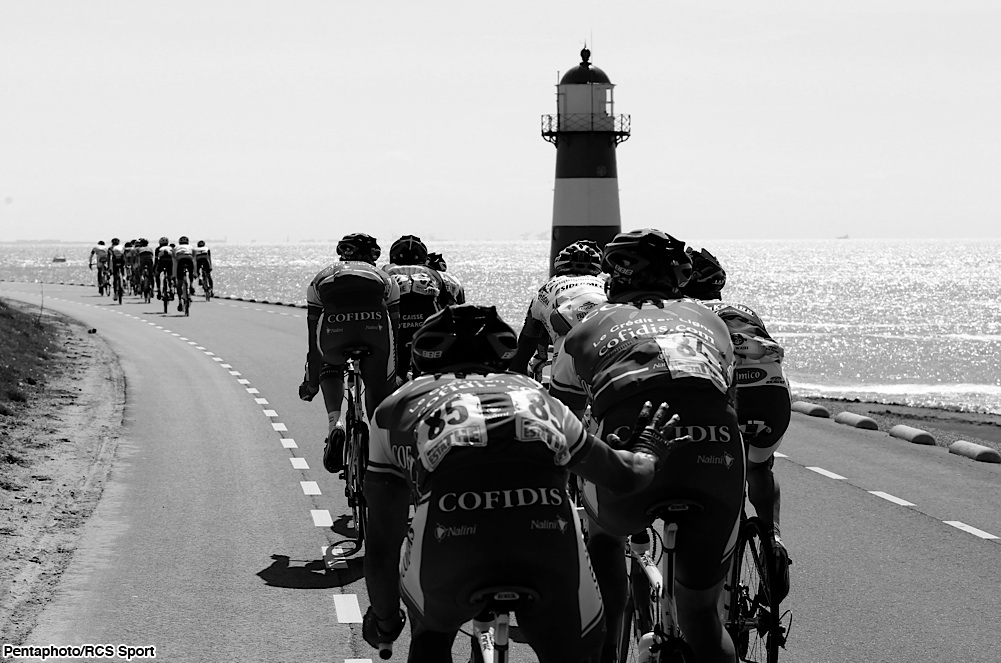Tour de France 2010Stage 1 - Rotterdam > > > Bruxelles - 223.5 km
Sunday, July 4, 2010
Stage Previews
Plain - A sporting perspective
Mind the gaps
The finish of the first stage of this Tour is in Brussels. Why Brussels? To celebrate the 65th birthday of Eddy Merckx and everything he has given to cycling. We will be crossing the Flanders region and will enter Belgium via Antwerp. The finish of this completely flat stage will take place in front of the Roi Baudouin stadium. It is difficult to envisage anything else than a sprint finish. However, it should be noted that there could be side winds, which could cause breaks in the pack, leading to gaps. The riders will have to be watchful.
(letour.com)
June 27 post:
The first road stage begins where the prologue left off in Rotterdam with a second crossing of the Erasmus bridge (Erasmusbrug).
From Rotterdam, the stage heads south for a brief tour of the Dutch coastline -- the same windswept coastline that shattered the field during stage 3 of this year's Giro d'Italia. Stage 1 of the Tour de France heads inland where as the Giro continued down the coast to Middleburg so strong winds along the coast will not affect this stage as much. The inland portion of the route will head through Flanders, home to one of the monuments of cycling, Tour of Flanders. Tom Boonen says the roads inland towards Bussels will be "narrow and hectic" and that this stage will be important to the Belgian guys.
After a very flat 224 km stage with no KOMs, there is a bump before the race finishes in front of the King Baudouin stadium in Brussels to celebrate Eddy Merckx's 65th birthday. Merckx, considered the greatest cyclist of all-time, was born east of Brussels in the small Belgian town of Meensel-Kiezegem on June 17, 1945 just one month after the end of World War II. The route will pass through Meise, 10 km before the finish, where he currently lives.
The first sprint finish of the Tour is always a chaotic, nervous affair for the overzealous peloton. — Steve

The Stage 1 profile looks like it sets up for sprint finish, but the route will pass the same stretch of windswept Holland coastline that shattered the field during Stage 3 of this past Giro d'Italia.
(steephill.tv)
Tour de France 2010Stage 1 - Rotterdam > > > Bruxelles - 223.5 km
Sunday, July 4, 2010
DépartROTTERDAM

• Once a stage town
• Population: 600,000
• Second most important city in the Netherlands
It’s the first Tour Start from Rotterdam but the Tour’s second visit to the city. In 1973 Belgian rider Willy Teirlinck won there at the finish of the first stage. The day before, on the prologue in Scheveningen, Joop Zoetemelk swept across the finish line just 80 hundredths of a second ahead of Raymond Poulidor. The Netherlands rejoiced and Poupou, as Poulidor was called, had never come so close to winning the Yellow Jersey.
Renowned for its architecture, the Dutch city of Rotterdam has earned an international reputation for its striking, modern constructions. The devastating aerial bombardment of 14 May 1940 reduced the town centre to ruins, leaving architects and town planners free to set a more modern stamp on the reconstructed city. In 1953, Rotterdam became the first European city to introduce a completely pedestrianised street, called the Lijnbaan. The ultra-modern Groothandelsgebouw building was constructed that same year, followed by the inauguration of the Euromast in 1960. The city has been transformed, with unparalleled daring and amazing technical genius, into an impressive, cosmopolitan metropolis. The Erasmus bridge by the architect Ben van Berkel, which has quickly become a symbol of the city, the Kunsthal by Rem Koolhaas and the KPN building by the Italian architect Renzo Piano are just a few examples of the architectural works which have, over recent decades, created the resolutely dynamic and inspired face of Rotterdam.
Arrivée
BRUXELLES

• 11 times a stage town
• Population: 154,000
• Région Bruxelles-Capitale: 1,000,000
• Capital of Belgium
• Capital of the European Union
Brussels is the most frequently visited international city on the Tour, which has called on its Belgian neighbour eleven times in the past. The calibre of the city’s prize winners is on a par with its status as a capital city: René Vietto in 1947, Laurent Jalabert in 1992, along with Bernard Hinault and Freddy Maertens… The Tour had the pleasure of starting from Brussels in 1958, the year of the Universal Exhibition, but has not been back for the last eighteen years. A most welcome return.
Brussels, a city with a rich history dating back thousands of years, has been the capital of Europe since 1992. The “European district” is home to all the European institutions and the main EU buildings. The most well known, and the most emblematic, is the European Parliament, known as the “Caprice des Dieux” by locals due to its oval shape, reminiscent of the packaging of Caprice des Dieux cheese. This district is the hub of European life. 40,000 people work here and a mix of languages can be heard from Place du Luxembourg to the market on Place du Châtelain. However, as well as being a European city, Brussels holds an international role. It has highest number of diplomats and journalists in the world, 1,400 international organisations and NGOs are based in the Belgian capital, as well as 2,000 foreign companies. In 2010, Brussels’ position as the heart of Europe will be emphasised when it takes over the Presidency of the European Union from Spain on 1 July for six months.
(letour.com)


